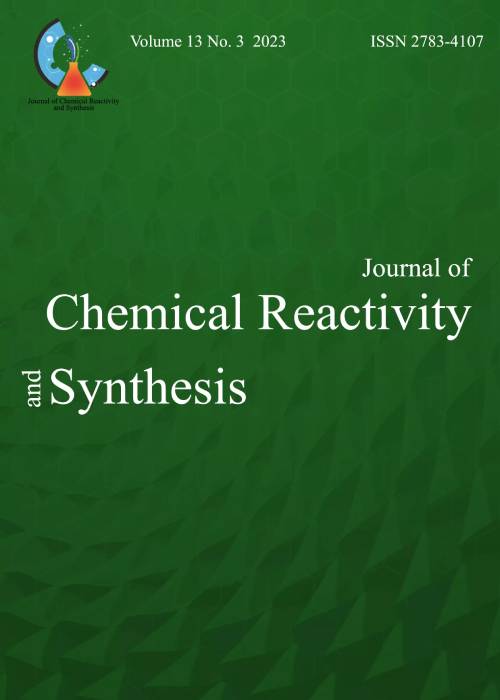فهرست مطالب
Journal of Chemical Reactivity and Synthesis
Volume:10 Issue: 4, Autumn 2020
- تاریخ انتشار: 1398/09/19
- تعداد عناوین: 6
-
Pages 141-147
Light emitting diodes (OLEDs) are one the newest lighting in industrial lighting which can be a promising candidate in this area. A typical reverse OLED is made from cathode, injection/transport electron and hole layers, emissive layer (EM). Electrons and holes after injection to EM are recombined in emissive layer which is an organic material. In reverse structure, holes inject EM well while electrons cannot be easily injected to emissive layer. Here, effect of lithium doped zinc oxide (LZO) on the led performance was investigated. The results showed that lithium can be increased conductivity of injection electron layer and facile to inject electron to emissive layer.
Keywords: Lighting, OLED, Injection electron, Lithium doping, Thin Film -
Pages 148-153
The 1,3-Dipolar cycloaddition reactions are the classic reaction in modern synthetic organic chemistry.The Huisgen cycloaddition is the reaction of a dipolarophile with a 1,3-dipolar compound that leads to 5-membered heterocycles. With the goal of identifying alkyne-like reagents for use in azide-alkyne Huisgen cycloaddition reactions, we used density functional theory (DFT) and polarized continuum model (PCM) computations. In this respect, we investigated the structure and energy of transition states in the reaction path and assessed the trends in the calculated activation barriers for the1,3-dipolar cycloaddition of azides with various substituted cyclooctynes in the gas and solution phases to interpret theoretically the origin of regioselectivity in the synthesis of disubstituted 1,2,3-triazole derivatives.
Keywords: 1, 3-Dipolar cycloaddition, density functional theory, 2, 3-triazole, polarized continuum model -
Pages 154-162
Potential energy surfaces (PES) for the ground and excited state intramolecular proton transfer (ESIPT) processes in N-salicilydene methyl furylamine(SMFA)have been studied usingCC2 level of theory. Our calculations suggest thenon-viability of ground state intramolecular proton transfer. Excited states PES calculations support the existence of ESIPT process in SMFA.The calculated results show that the intramolecular hydrogen bond were formed in the S0 state, and upon excitation, the intramolecular hydrogen bonds between - OH group and nitrogen atom would be strengthened in the S1 state, which can facilitate the proton transfer process effectively. The calculations indicate two S1/S0 conical intersections (CIs) which provide radiation-less decay to the ground state. At the CIs, two barrier-free reaction coordinates direct the excited system to the ground state of enol-type minimum.The keto-type S1 state attained by barrier less proton transfer is found to be unstable via a torsional motion, which provides fast access to a S1−S0 conical intersections. From the conical intersection, a barrier less reaction path directs the system back to the enol-type minimum of the S0 potential energy surface, thus closing the photocycle.
Keywords: Schiff base, Intramolecular Proton Transfer, Photo chromism -
Pages 163-166
Densities, viscosities and derived properties for binary and ternary mixtures consist of Benzene, Cyclohexane and N,N-Dimethyl acetamide were measured at temperatures of 298.15 K in the whole range of mole fractions. The measured data and calculated values of all systems are in good agreement with literature and Redlich-Kister and the Cibulka equations
Keywords: Density, Viscosity, Excess molar volume, N, N-Dimethyl acetamide -
Pages 167-174
Selective gas-phase oxidation of o-xylene to phthalic anhydride over VPO/HZSM-5 catalysts was investigated. The catalysts with various P/V ratio were facilely synthesized by impregnation method. The prepared catalysts were characterized by several techniques such as SEM, TPD-NH3, H2-TPR, FT-IR, BET and XRD. The effects of P/V ratio (1.6–2.4), reaction temperature (350–450 ◦C), Ox/O2 ratio (0.15–0.60) and gas hourly space velocity (G.H.S.V) of O2/N2 (600–1200 h-1) on yield of PA were studied by Box–Behnken design. The influence of independent factors and their quadratic interactions were examined by means of the Analysis of Variance (ANOVA). Present results indicate that P/V ratio has a different effect on the conversion and selectivity of PA. The catalyst with P/V ratio = 2.0, Ox/O2 ratio = 0.37, G.H.S.V of 770 h-1 and reaction temperature of 370 ◦C produced maximum yield of PA (80.7 %). The analysis revealed that the predicted results agree well with the experimental data (P/V ratio = 2.0, Ox/O2 ratio = 0.38, G.H.S.V of the carrier gas = 900 h-1 and reaction temperature of 400 ◦C with 74.3% yield).
Keywords: VPO, HZSM-5 catalyst, phthalic anhydride, selective oxidation, o-xylene -
Pages 175-185A new PVC based membrane using benzo-18-crown-6 as an ionophore has been developed as a calcium ion selective electrode. The electrode comprises of ionophore (4%), PVC (30%) and plasticizer (63%). The electrode shows a linear dynamic response in the concentration range of 1×10−5 M to 1×10−1 M with a Nernstian slope of 29.8 mV/decade and detection limit is 4.0×10−6 M. The proposed sensor shows reasonably good selectivity with respect to alkali, alkaline earth and transition metal ions. It can be used in the pH range of 5 to 12. The proposed electrode also was applied for the direct determination of Ca2+ cation in doubly distilled deionized water samples spiked with different concentrations of calcium. This electrode was also used for determination of Ca2+ in real samples with a very good recovery.Keywords: Calcium (II) cation, Ion selective electrode, Potentiometry


